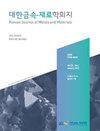Machine Learning-Based Prediction of Grain Size from Colored Microstructure
IF 1.4
4区 材料科学
Q4 MATERIALS SCIENCE, MULTIDISCIPLINARY
引用次数: 0
Abstract
We constructed a convolutional neural network to estimate average grain size from microstructure images. In the previous study from our research group, the network was trained using GB-type images in which the grain matrix and grain boundary were represented in white and black, respectively. The model well estimated the same GB-type images, but did not properly predict CL-type images where grain boundaries were defined by color contrast between grains. In the present study, the convolutional neural network was trained using CL-type microstructure images, and evaluated the average grain size, for comparison with the previous GB-type model. The relationship between the microstructure image and the average grain size was determined using regression rather than classification. Then, the results were compared with the previous ones. Finally, the proposed approach was used for actual microstructural image analysis. Mid-layer images were extracted to examine how the network recognizes the characteristics of microstructures, such as grain color and grain boundary. Like the previous GB-type model, the present CL-type model seems to estimate the average grain size from the curvature of the grain boundary through edge detection of the grain boundaries. However, the GB- and CL-type models only properly predicted the grain size from the same kind of images as the training data, because the definitions of the grain boundaries of the two models were different.基于机器学习的彩色显微组织晶粒度预测
我们构建了一个卷积神经网络来从微观结构图像中估计平均晶粒尺寸。在我们研究小组之前的研究中,使用GB型图像训练网络,其中晶粒矩阵和晶界分别用白色和黑色表示。该模型很好地估计了相同的GB型图像,但没有正确预测CL型图像,其中晶界由晶粒之间的颜色对比度定义。在本研究中,使用CL型微观结构图像训练卷积神经网络,并评估平均晶粒度,以与以前的GB型模型进行比较。使用回归而不是分类来确定微观结构图像和平均晶粒度之间的关系。然后,将结果与之前的结果进行比较。最后,将所提出的方法用于实际的微观结构图像分析。提取中间层图像以检查网络如何识别微观结构的特征,如晶粒颜色和晶界。与之前的GB型模型一样,当前的CL型模型似乎通过晶界的边缘检测从晶界的曲率来估计平均晶粒尺寸。然而,GB型和CL型模型只能从与训练数据相同的图像中正确预测晶粒尺寸,因为这两个模型的晶界定义不同。
本文章由计算机程序翻译,如有差异,请以英文原文为准。
求助全文
约1分钟内获得全文
求助全文
来源期刊

Korean Journal of Metals and Materials
MATERIALS SCIENCE, MULTIDISCIPLINARY-METALLURGY & METALLURGICAL ENGINEERING
CiteScore
1.80
自引率
58.30%
发文量
100
审稿时长
4-8 weeks
期刊介绍:
The Korean Journal of Metals and Materials is a representative Korean-language journal of the Korean Institute of Metals and Materials (KIM); it publishes domestic and foreign academic papers related to metals and materials, in abroad range of fields from metals and materials to nano-materials, biomaterials, functional materials, energy materials, and new materials, and its official ISO designation is Korean J. Met. Mater.
 求助内容:
求助内容: 应助结果提醒方式:
应助结果提醒方式:


